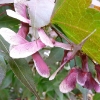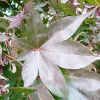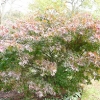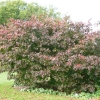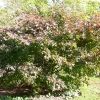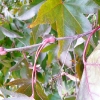Features
A bushy Japanese maple with deep red/purple leaves which are split into 5 or 7 lobes and turn scarlet in autumn. The spring flowers are small and purple, followed by red samara fruits in summer and autumn.
What to use it for
A good, and commonly used, tree for a small to medium size garden which can provide shade in the summer before its glorious autumn display. It suits most styles of garden, is low maintenance and can be an interesting focal point. It is suitable for being grown in containers (so long as it is kept well watered) and could also be effective in a large rock garden.
How to look after it
Ensure that it is watered in drought conditions, particularly in the first few years of growth.
How to prune it
While establishing an Acer palmatum the plant should be staked to provide it with additional support and pruned to remove any badly placed or crossing stems. Once established, pruning should be kept to the bare minimum – only removing dead, damaged, diseased and crossing stems.
Any pruning should be done in winter when the tree is completely dormant. If done at any other time the plant will ‘bleed’ sap and be weakened as a result. Minor pruning of thin stems could be undertaken in late summer or early autumn if necessary.
How to propagate it
Propagate by softwood cuttings in mid-spring (you may need to bring the parent plant under cover to get it to put on enough growth to take the cutting this early) or early summer. Alternatively carry out simple layering in mid/late autumn or early spring.
If you have the skill, grafting can be done in late winter or summer (using a spliced side veneer graft so the scion is not pushed off by the rising sap).
Common problems
Acers may be prone to infestations of aphids or horse chestnut scale. They may also be susceptible to tar spot, sooty bark disease, verticillium wilt and winged cork.
Leaf scorch can be a problem if there is a lack of soil moisture or too much exposure to the elements (eg intense sunlight, high winds).
Other useful information
The ‘palmatum’ species of acers are so named since their lobed leaves resemble outstretched hands, ie ‘palms’.
Acer palmatum plants are popular bonsai subjects.
This plant has received the Award of Garden Merit from the RHS.


